Essential Guide to Moving Into a Care Home

Care homes come in different types, and getting to know the options is a helpful starting point. Some offer residential care, which supports people with everyday tasks like getting dressed, taking medication, and preparing meals. Others provide nursing care for those with more complex medical needs. There are also homes that specialise in dementia care, where staff are trained to support residents with memory loss and cognitive challenges. What makes a care home feel right can vary from person to person. It might be the welcoming atmosphere, the kindness of the staff, or knowing that someone is always there to lend a hand. Some homes offer beautiful gardens, home-cooked meals, and regular activities that help residents feel part of a community. But above all, good care homes make sure each resident is treated with dignity, respect, and compassion.
If you’re starting to explore care options, there are helpful resources available. Local councils can guide you through the process, including advice about funding and assessments. It’s also worth reading up on care home standards and looking out for guidance from organisations that focus on supporting older people and their families. Moving into care should bring peace of mind and a sense of security, and the right information can make all the difference when planning for that next chapter.
Finding the Right Care Home
Finding the right care home can take a little time, but it’s well worth the effort. Everyone’s needs are different, so what feels right for one person might not suit someone else. That’s why it’s important to look beyond the basics and think about what really matters to the individual who will be moving in. Location is often a good place to start. Some people prefer to stay close to their current community, while others might want to move nearer to family or loved ones. Being in familiar surroundings or having regular visitors can make a real difference to someone’s wellbeing.
The quality of care is, of course, essential. Look for homes that offer person-centred care, where staff take time to get to know each resident and their routines, likes and dislikes. A home that listens and adapts to individual preferences is more likely to feel comfortable and reassuring from day one. You can learn a lot by visiting a care home in person. It’s a good chance to meet staff, observe how residents are supported, and get a feel for the atmosphere. Some homes offer trial stays or day visits, which can help make the transition feel more natural.
It’s also helpful to ask others for their thoughts. Friends, relatives or your GP may be able to recommend local homes, or point you towards services with a strong reputation. Checking inspection reports and reading reviews online from websites like Carehome.co.uk can also provide useful insights into how a home is run. Most importantly, listen to your instincts. A care home should feel safe, respectful and welcoming. Whether it’s a quiet corner to read the paper or regular group activities that encourage connection, the right environment can help someone settle in and feel at home.


Understanding Care Home Fees
One of the most common concerns when considering a move into care is the cost. Care home fees can vary depending on where you live, the type of care needed, and the services the home provides. It can feel a bit overwhelming at first, but taking time to understand what’s involved can help you plan ahead with more confidence. Some care homes offer residential care, which generally includes accommodation, meals, and help with everyday tasks. Others offer nursing care, where qualified nurses are available around the clock to support people with more complex health needs. Because of this, fees can differ not just between homes, but also between residents within the same home, depending on individual needs.
You might be eligible for financial support. Local councils can carry out a financial assessment to see whether they can help with some or all of the costs. This takes into account income, savings, and any property owned. Depending on the outcome, the council may pay a contribution towards the fees, or in some cases, the full amount. There are also other sources of support, if you’re not sure what you might be entitled to, organisations like Age UK can be a good place to start, or you may wish to speak to an independent financial adviser who specialises in care funding.
When visiting a care home, it’s important to ask what’s included in the weekly fee. Some homes include extras like hairdressing or outings, while others may charge separately for these. Understanding what is and isn’t covered from the outset can help avoid surprises later on. Although talking about money can sometimes feel difficult, clear and open conversations at the beginning can help families feel more prepared and reduce stress during the move. The right care home will be happy to explain their fees in detail and guide you through the next steps if you decide to proceed.
Creating a Care Home Checklist
Once a care home has been chosen, having a checklist can make the move feel more manageable. There’s often a lot to think about, so writing things down helps keep everything organised and ensures nothing important gets overlooked.
A good starting point is to think about what the person moving in will need straight away. This might include clothes, toiletries, personal items and any essential documents. Bringing familiar belongings can help make the new room feel more homely, whether it’s a favourite chair, some framed photos or a well-loved blanket. It’s also helpful to think about health and daily care. Make a note of any medication that needs to be brought in, along with up-to-date prescriptions and information about any ongoing medical needs. The care home will usually go through this with you before the move, but having everything ready in advance can make the transition smoother.
You might want to jot down any questions for the care home team. This could be about how they manage personal care routines, how meals are planned, or what social activities are available. It’s also worth asking about how family visits work and whether there are any welcome plans in place to help new residents settle in. Some practical jobs will need to be done too, like arranging transport, updating contact details and letting key people or organisations know about the move. Keeping track of who you’ve notified can help avoid any missed letters or confusion later on.
A checklist is not just for the day of the move. It can be updated and added to as you go along, and it often helps families feel more in control during what can be an emotional time. Knowing that everything is in hand brings peace of mind and allows everyone to focus on helping their loved one feel comfortable in their new home.
Who to Notify About the Move
When someone moves into a care home, it’s important to let the right people and organisations know about the change. Doing this early on helps to avoid missed letters, confusion over payments, or disruption to services. A simple list can help you stay on top of it all.
Start with close family and friends, as they’ll want to stay in touch and may be able to lend a hand during the move. If the person moving in has a power of attorney in place, they should also be kept fully informed. Next, speak to your local council and GP. The council will need to know about the change in living arrangements, especially if they’re involved in any care planning or financial support. The GP should be told so that medical records can be updated and prescriptions continue without delay.
There are a number of other organisations that may need to be informed. These can include:
- The Department for Work and Pensions (for benefits such as State Pension, Attendance Allowance or Pension Credit)
- HMRC
- Banks and building societies
- Insurance providers (for example, home or contents insurance)
- TV Licensing
- The Post Office, if setting up mail redirection
- Any private healthcare providers or pension schemes
- Utility companies, if the person is leaving their previous home
Depending on the situation, you may also need to contact a solicitor, accountant, or financial adviser, particularly if there are property or financial matters to manage. Once notifications are done, it’s useful to keep a written record of who you’ve contacted, along with any reference numbers or follow-up dates. This can make it much easier to resolve any issues quickly, should they arise. Don’t forget to keep the care home informed too. If there are any changes to emergency contacts, medication, or personal preferences, letting staff know early ensures they have everything in place to offer the best possible support from day one.
Prioritising Health and Wellbeing
A move into a care home isn’t just about day-to-day help, it’s also about supporting a person’s overall health and sense of wellbeing. Good care homes take a joined-up approach, making sure that residents feel safe, cared for, and able to live as well as possible. Health needs vary from person to person, which is why personalised care is so important. Some residents may need regular help with medication or nursing support for ongoing conditions. Others might simply benefit from gentle encouragement with things like mobility, nutrition, or staying active. Care staff work closely with GPs and other healthcare professionals to make sure any medical needs are understood and managed properly.
Physical health is just one part of the picture. Mental wellbeing and emotional support are just as important. Many care homes offer social activities, hobbies and events that help residents stay connected and involved, whether that’s a quiet book club or a weekly games afternoon. The opportunity to spend time with others, share stories or just enjoy a chat over a cup of tea can make a real difference to someone’s mood and outlook. Most care homes provide balanced, home-cooked meals tailored to individual dietary needs. Mealtimes can also be a social highlight of the day, offering comfort and routine.
Staff training plays a big part in supporting wellbeing too. In homes where residents are living with dementia or complex health conditions, it’s important that carers understand how best to support those needs with patience and kindness. Many homes also offer access to visiting professionals such as physiotherapists, chiropodists or occupational therapists, depending on individual requirements. Environment matters as well. Some people feel uplifted by a garden view, a cosy communal lounge, or even a quiet space to enjoy some privacy. These small details help create a sense of calm and belonging.

Can You Bring Your Pet?
For many people, pets are part of the family, and a real source of comfort and joy. So, if you or your loved one has a pet, it’s important to understand how different care homes approach this. Some care homes do welcome pets, particularly smaller ones, though policies can vary quite a bit. A few may allow residents to bring a cat or small dog, while others might have a home pet that everyone can enjoy spending time with. In some cases, residents may not be able to bring their own animal, but regular pet therapy visits may be offered instead.
If keeping a pet is important, it’s worth asking early on whether the care home allows it and what conditions are in place. For example, is there an outdoor space for walking a dog? Are staff able to help with feeding or vet visits if needed? It’s also helpful to ask whether the pet would need to stay in the resident’s room, or if it could be part of the wider community.
Even if a resident isn’t able to bring their own pet, having animals around the home in some way can still bring comfort. Many care homes now recognise the positive impact of animals on wellbeing, particularly for people living with dementia, where familiar routines and soothing companionship can be especially reassuring. Some homes have links with local animal charities or host regular visits from trained therapy pets. These visits can be a highlight of the week and often spark conversation, smiles and fond memories.
If there’s a beloved pet that can’t move in, it may still be possible to arrange regular visits. Some families continue to bring in dogs or other pets when they come to see their loved one, if the home allows it. This can help keep that bond alive and offer something familiar to look forward to. For many residents, knowing their pet is safe, nearby, or even just welcome for visits can be a great comfort. It’s one of those small details that can make a big difference when settling into a new home.
Taking the Next Step with Confidence at Queens View Harbour in Troon
Whether you’re just beginning to explore the idea of residential care or are helping a loved one prepare for the move, taking the time to understand the different types of care, the costs involved, and what day-to-day life looks like can help you make choices that feel right for your situation. From finding a care home that feels safe and welcoming, to understanding fees and knowing who to notify, each part of the process plays a role in making the transition as smooth as possible. A thoughtful checklist can keep things on track, while clear communication with care home staff ensures your loved one’s needs are properly supported from the start.
Health, wellbeing and personal comfort should always be at the heart of care, whether that’s regular medical support, meaningful activities, or even the chance to stay close to a much-loved pet. Choosing a care home that truly values each individual helps build a sense of belonging and trust. If you’re looking for a care home that combines professional support with a homely, compassionate environment, Queens View Harbour Care Home in Troon is here to help. Our experienced team is on hand to answer any questions you may have and to guide you through each stage of the process. Get in touch today to arrange a visit or speak to a member of our team – we’d be delighted to welcome you.





